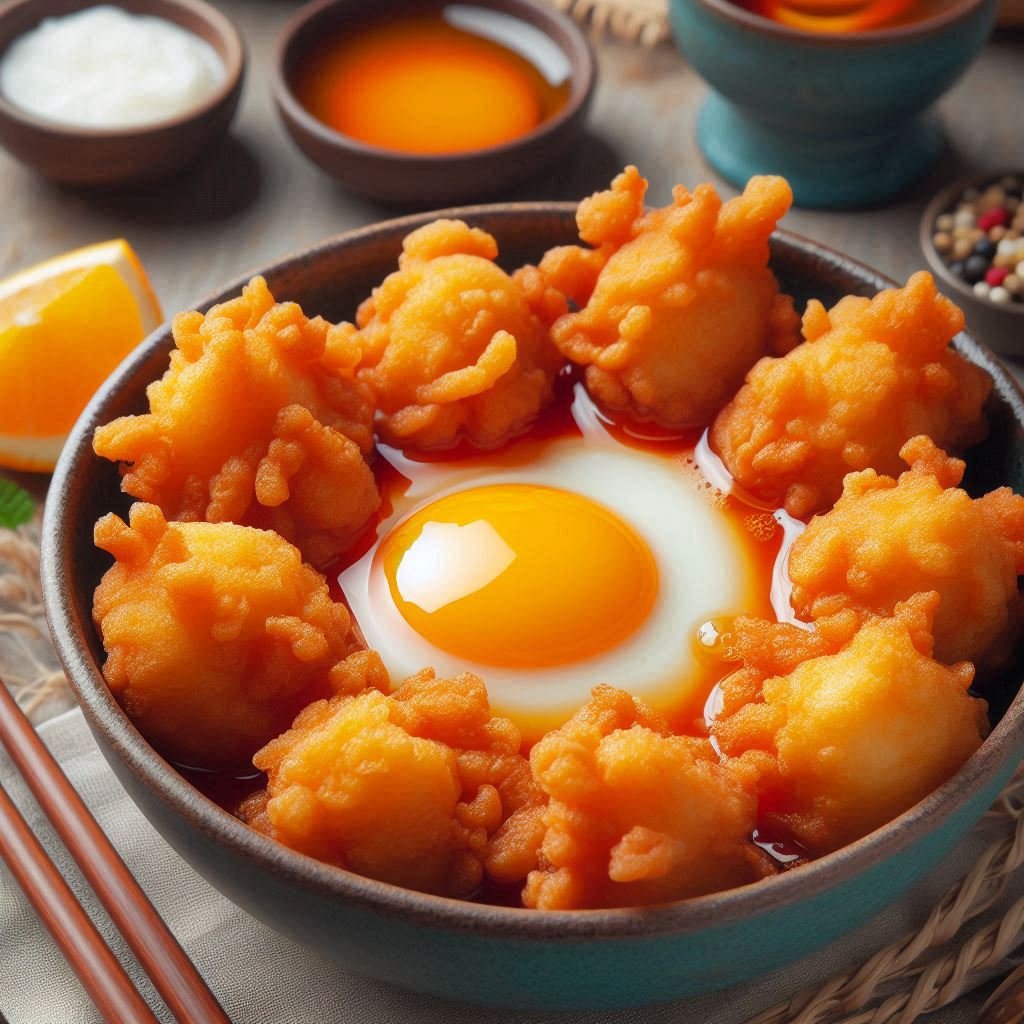Tokneneng, a beloved Filipino street food delicacy, has been captivating taste buds and winning hearts for generations. This unique culinary creation consists of hard-boiled chicken eggs coated in a vibrant orange batter and deep-fried to perfection. As a staple in Philippine street food culture, Tokneneng represents more than just a quick snack; it embodies the creativity, resourcefulness, and rich flavors that define Filipino cuisine. In this comprehensive exploration, we will delve into the origins, preparation methods, nutritional aspects, and cultural significance of Tokneneng, shedding light on why this simple yet intriguing dish continues to be a favorite among locals and tourists alike.
The Origins and History of Tokneneng
Tracing the Roots
The exact origins of Tokneneng are somewhat shrouded in mystery, as is often the case with traditional street foods. However, food historians and culinary experts generally agree that Tokneneng has been a part of Philippine cuisine for several decades, if not centuries. The dish is believed to have evolved from the need to create filling, affordable snacks using readily available ingredients. Eggs, being a versatile and nutritious food source, naturally became the centerpiece of this inventive street food.
Cultural Influences
Philippine cuisine is a melting pot of various cultural influences, including Spanish, Chinese, and American. While Tokneneng is distinctly Filipino, its concept of battered and fried foods may have been inspired by similar dishes from other cultures. For instance, the Spanish influence on Philippine cuisine introduced various frying techniques, which could have contributed to the development of Tokneneng’s cooking method.
Evolution Over Time
Over the years, Tokneneng has undergone subtle changes and regional variations. While the basic concept remains the same, different areas in the Philippines may have their own twists on the recipe, such as variations in the batter ingredients or accompanying sauces. Despite these regional differences, the core identity of Tokneneng as a beloved street food has remained constant throughout its history.
Preparation and Ingredients
The Essential Components
At its core, Tokneneng consists of two main elements: the egg and the batter. Let’s break down each component:
- The Egg: Traditionally, chicken eggs are used for Tokneneng. These are hard-boiled to achieve a firm texture that can withstand the frying process.
- The Batter: The distinctive orange batter is what sets Tokneneng apart visually. It typically includes the following ingredients:
- All-purpose flour
- Cornstarch
- Salt
- Ground black pepper
- Water
- Orange food coloring (for the vibrant hue)
Step-by-Step Preparation Process
- Boiling the Eggs: Fresh chicken eggs are carefully boiled until hard. The cooking time is crucial to ensure the yolks are fully cooked but not overcooked, which could lead to a grayish ring around the yolk.
- Preparing the Batter: The dry ingredients (flour, cornstarch, salt, and pepper) are mixed thoroughly. Water is gradually added to create a smooth, slightly thick batter. Orange food coloring is then incorporated to achieve the signature bright color.
- Coating the Eggs: Once cooled and peeled, the hard-boiled eggs are dipped into the prepared batter, ensuring an even coating.
- Frying: The batter-coated eggs are carefully lowered into hot oil and deep-fried until the exterior becomes crispy and golden-orange.
- Draining and Serving: After frying, the Tokneneng is removed from the oil and allowed to drain on paper towels to remove excess oil.
Nutritional Profile and Health Considerations
Nutritional Breakdown
Tokneneng, while delicious, is a calorie-dense food due to its preparation method. Here’s a general nutritional breakdown for one serving of Tokneneng (based on a single large egg):
| Nutrient | Amount |
|---|---|
| Calories | ~250-300 kcal |
| Protein | 6-8 g |
| Carbohydrates | 15-20 g |
| Fat | 18-22 g |
| Cholesterol | ~185 mg |
| Sodium | 200-300 mg |
Health Benefits and Concerns
While Tokneneng is not typically considered a health food, it does offer some nutritional benefits:
- Protein Source: Eggs are an excellent source of high-quality protein, essential for muscle building and repair.
- Vitamins and Minerals: Eggs contain various vitamins and minerals, including vitamin A, B vitamins, and selenium.
- Satiety: The combination of protein and fat in Tokneneng can provide a feeling of fullness, potentially reducing overall calorie intake.
However, there are also some health considerations to keep in mind:
- High in Calories: Due to the deep-frying process, Tokneneng is calorie-dense and should be consumed in moderation.
- Cholesterol Content: While dietary cholesterol’s impact on blood cholesterol levels varies among individuals, those with cholesterol concerns should be mindful of their intake.
- Sodium Levels: The batter and any accompanying sauces can contribute to a high sodium content, which may be a concern for individuals managing their salt intake.
Cultural Significance and Popularity
Street Food Culture
Tokneneng holds a special place in Philippine street food culture. It’s commonly found in bustling markets, outside schools, and in neighborhood street corners. The sight of vendors skillfully preparing Tokneneng has become an integral part of the urban landscape in many Philippine cities and towns.
Affordable Sustenance
One of the reasons for Tokneneng’s enduring popularity is its affordability. In a country where economic disparities exist, Tokneneng provides a filling and satisfying snack at a price point accessible to many. This affordability has contributed to its status as a “people’s food,” enjoyed across various socioeconomic backgrounds.
Nostalgia and Comfort
For many Filipinos, Tokneneng evokes feelings of nostalgia and comfort. It’s often associated with childhood memories, after-school snacks, or quick bites during busy workdays. This emotional connection has helped maintain Tokneneng’s popularity across generations.
Tourism Appeal
As Philippine cuisine gains more international recognition, Tokneneng has become a point of interest for culinary tourists. Its unique appearance and flavor profile make it an intriguing option for those looking to explore authentic Filipino street food experiences.
Regional Variations and Similar Dishes
Kwek-Kwek: The Quail Egg Cousin
Closely related to Tokneneng is Kwek-Kwek, which follows the same principle but uses quail eggs instead of chicken eggs. The smaller size of Kwek-Kwek makes it even more popular as a quick, bite-sized snack.
Regional Twists
While the basic recipe remains consistent across the Philippines, some regions have developed their own variations:
- Batter Variations: Some areas may add local spices or herbs to the batter for a unique flavor profile.
- Serving Styles: The accompaniments and sauces served with Tokneneng can vary by region, reflecting local taste preferences.
- Cooking Methods: While deep-frying is the standard, some variations may experiment with different cooking techniques to achieve a similar result with less oil.
International Counterparts
While Tokneneng is uniquely Filipino, similar concepts of battered and fried eggs exist in other cuisines:
- Scotch Eggs: A British dish consisting of a hard-boiled egg wrapped in sausage meat, coated in breadcrumbs, and deep-fried.
- Nigerian Egg Rolls: Similar to Tokneneng, these are hard-boiled eggs coated in a flour batter and deep-fried.
- Indian Egg Bonda: A South Indian snack made by coating boiled eggs in a spiced batter and deep-frying.
The Art of Serving and Enjoying Tokneneng
Traditional Serving Methods
Tokneneng is typically served hot, fresh from the fryer. Street vendors often skewer the Tokneneng on bamboo sticks for easy handling and eating on the go. It’s commonly served with a dipping sauce, which can vary but often includes a vinegar-based condiment with chilies, garlic, and sometimes soy sauce.
Accompaniments and Pairings
While Tokneneng is delicious on its own, it’s often enjoyed with complementary foods and drinks:
- Drinks: Cold beverages like sago’t gulaman (a sweet drink with tapioca pearls and gelatin) or fresh fruit juices are popular pairings.
- Other Street Foods: Tokneneng is sometimes combined with other street snacks like fishballs, squid balls, or grilled intestines (isaw) for a varied street food experience.
- Vinegar Dips: The tangy, spicy vinegar dip is considered essential by many, as it cuts through the richness of the fried egg.
Eating Etiquette
Eating Tokneneng is a casual affair, typically done standing up at street food stalls. The proper way to eat it is to bite directly into the Tokneneng or to cut it into pieces and dip each piece into the sauce before eating.
Economic Impact and Livelihood
Micro-entrepreneurship
Tokneneng vendors represent a significant segment of micro-entrepreneurs in the Philippines. For many individuals, selling Tokneneng and other street foods provides a means of livelihood with relatively low start-up costs.
Economic Contributions
The street food sector, including Tokneneng vendors, contributes to the informal economy of the Philippines. While exact figures are difficult to quantify due to the informal nature of the business, it’s estimated that street food vendors collectively contribute millions of pesos to the economy annually.
Employment Opportunities
The Tokneneng trade creates employment opportunities not just for vendors, but also for suppliers of eggs, batter ingredients, and cooking equipment. This creates a small but significant economic ecosystem around this popular street food.
Modern Interpretations and Culinary Innovations
Gourmet Versions
As Filipino cuisine continues to evolve and gain international recognition, some chefs have begun creating gourmet versions of Tokneneng. These upscale interpretations might include:
- Premium Ingredients: Using organic or free-range eggs, and high-quality spices in the batter.
- Fusion Flavors: Incorporating international flavors into the batter or dipping sauces.
- Presentation: Elevating the presentation for fine dining environments.
Healthier Alternatives
In response to growing health consciousness, some cooks have developed healthier versions of Tokneneng:
- Air Fryer Tokneneng: Using air fryers to achieve a similar crispy texture with less oil.
- Baked Versions: Experimenting with baking methods to reduce the fat content.
- Alternative Flours: Using whole grain or gluten-free flours in the batter for added nutritional value.
Tokneneng-Inspired Products
The popularity of Tokneneng has inspired the creation of related products:
- Tokneneng-flavored Snacks: Commercial snack foods mimicking the flavor profile of Tokneneng.
- Ready-to-Cook Kits: Pre-packaged ingredients for making Tokneneng at home.
- Tokneneng-Inspired Dishes: Incorporating the flavors and concept of Tokneneng into other dishes, such as salads or sandwiches.
The Enduring Legacy of Tokneneng
Tokneneng stands as a testament to the ingenuity and resourcefulness of Filipino culinary tradition. From its humble origins as a street food staple to its current status as a beloved national snack, Tokneneng has proven its staying power in the ever-evolving landscape of Philippine cuisine. Its simplicity belies a complex interplay of flavors, textures, and cultural significance that continues to captivate both locals and visitors alike.
As we look to the future, Tokneneng is likely to remain an integral part of Philippine food culture. Whether enjoyed in its traditional form from street vendors or reimagined by innovative chefs, Tokneneng represents more than just a snack; it embodies the spirit of Filipino cuisine – unpretentious, flavorful, and deeply rooted in community and tradition.
In an era of globalization and changing food trends, Tokneneng serves as a delicious reminder of the enduring appeal of authentic, locally-developed foods. As long as there are bustling streets in the Philippines, it’s a safe bet that the enticing aroma of freshly fried Tokneneng will continue to waft through the air, inviting passersby to indulge in this simple yet satisfying treat.
Disclaimer: While every effort has been made to ensure the accuracy of the information presented in this blog post, culinary traditions and practices may vary. Nutritional information is approximate and can vary based on specific preparation methods and ingredients used. Readers are encouraged to consult local sources or culinary experts for the most up-to-date and region-specific information about Tokneneng. If you notice any inaccuracies in this post, please report them so we can promptly make corrections.




